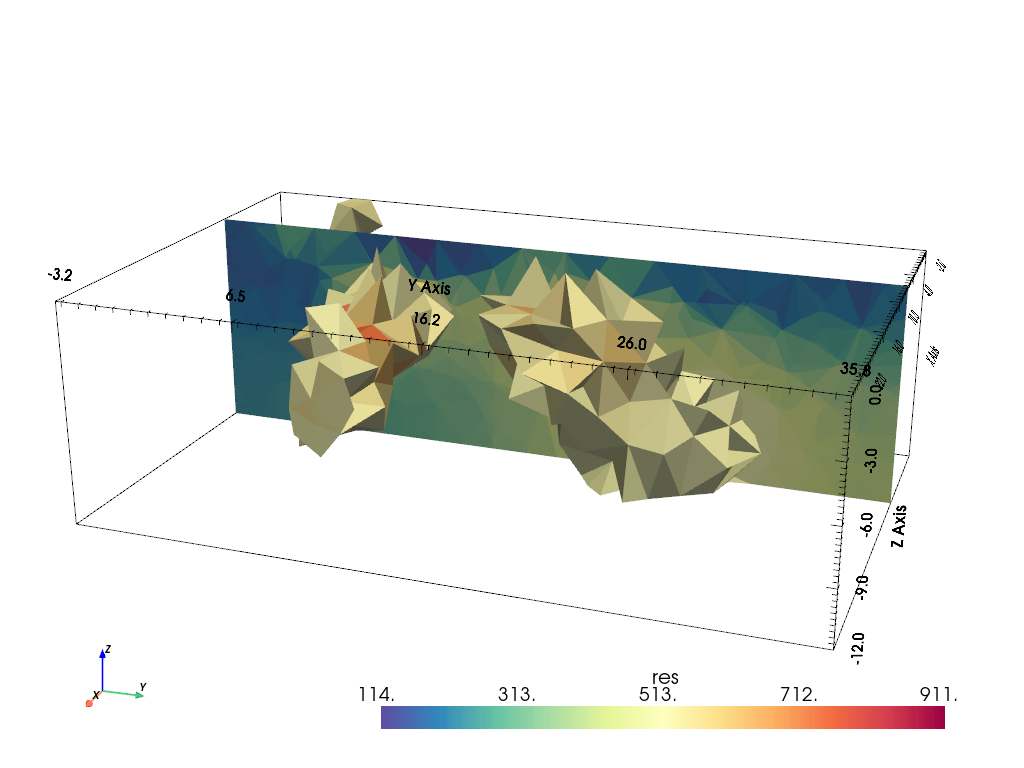Note
Go to the end to download the full example code.
3D surface ERT inversion#
Inversion of 3D surface ERT field data (the gallery) The data was measured by T. Günther and F. Donner in 2000 with the ERT instrument of the TU Bergakademie Freiberg and used for the PhD thesis of Günther (2004).
We import the pygimli library and toolboxes for mesh, plot and ERT.
import pygimli as pg
import pygimli.meshtools as mt
from pygimli.physics import ert
from pygimli.viewer import pv
We load the data file from the example repository. It represents a surface ERT array in a 14x9 electrode grid with a spacing of 2.5m (Günther, 2004). Data are measured using the dipole-dipole array in both x and y direction.
data = pg.getExampleData("ert/gallery3d.dat")
data["k"] = ert.createGeometricFactors(data, dim=3)
print(data)
Data: Sensors: 126 data: 753, nonzero entries: ['a', 'b', 'k', 'm', 'n', 'rhoa', 'valid']
For generating the mesh, we first create a piecewise-linear complex, i.e. the boxes for inversion region and background and mesh it then.
plc = mt.createParaMeshPLC3D(data, paraDepth=12, paraMaxCellSize=3,
surfaceMeshQuality=34)
mesh = mt.createMesh(plc, quality=1.3)
print(mesh)
Mesh: Nodes: 4142 Cells: 23026 Boundaries: 46977
We estimate an error using 2% relative error and an absolute error of 100uV at an assumed current of 100mA which is almost zero.
data["err"] = ert.estimateError(data, relativeError=0.02)
mgr = ert.ERTManager(data)
mgr.invert(mesh=mesh, verbose=True)
--------------------------------------------------------------------------------
--------------------------------------------------------------------------------
inv.iter 1 ... --------------------------------------------------------------------------------
inv.iter 2 ... --------------------------------------------------------------------------------
inv.iter 3 ... --------------------------------------------------------------------------------
inv.iter 4 ... ################################################################################
# Abort criterion reached: dPhi = 1.17 (< 2.0%) #
################################################################################
8660 [438.7882702562697,...,522.355230168612]
We visualize the result by a resistivity threshold and a slice using pyVista
pd = mgr.paraDomain
pd["res"] = mgr.model
pl, _ = pg.show(pd, label="res", style="surface", cMap="Spectral_r", hold=True,
filter={"threshold": dict(value=500, scalars="res")})
pv.drawMesh(pl, pd, label="res", style="surface", cMap="Spectral_r",
filter={"slice": dict(normal=[-1, 0, 0], origin=[5, 15, -2])})
pl.camera_position = "yz"
pl.camera.azimuth = 20
pl.camera.elevation = 20
pl.camera.zoom(1.2)
_ = pl.show()

/home/florian/actions-runner/_work/pyGIMLi/pyGIMLi/venv-doc-py311/lib/python3.11/site-packages/pyvista/plotting/plotter.py:7206: UserWarning: Not within a jupyter notebook environment.
Ignoring ``jupyter_backend``.
warnings.warn(
References#
Günther, T. (2004): Inversion Methods and Resolution Analysis for the 2D/3D Reconstruction of Resistivity Structures from DC Measurements. PhD thesis, University of Mining and Technology, Freiberg, available on http://nbn-resolving.de/urn:nbn:de:swb:105-4152277.
Total running time of the script: (3 minutes 18.957 seconds)